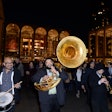After 10 years of discussing a change to the customary loop course, Los Angeles Marathon officials debuted a point-to-point course on Sunday. While the new route—a response to ministers’ complaints that the former course interfered with Sunday services—helped to alleviate the marathon’s impact on churches and businesses along the race’s path, it also presented organizers with a new challenge: transporting 25,000 racers to and from the start and finish lines from their cars or homes. (The previous loop course, which began and ended downtown, prevented the need for such logistical concerns.)
“I thought it was going to be a nightmare getting runners to the line,” said executive race director Terry Collier, “but it went without a hitch.”
In an agreement between race organizers and the Metropolitan Transit Authority, marathoners were able to ride the Metro for free on race day, with marathon organizers covering the cost. Metro also increased its services, running 14 six-car trains (it usually only runs nine four-car trains) every six minutes for a potential maximum transportation of 7,500 people per hour.
While the use of public transportation may have been a strange concept for the race’s native Angeleno participants, other marathon features, such as 10 entertainment stations dispersed throughout the course, reminded participants that they were in the entertainment capital of the world. With more live on-course performances than any other marathon, the race included entertainment ranging from a starting-line a cappella performance of “Amazing Grace” by former American Idol finalist Ace Young to marimba-playing artists on the streets of Boyle Heights.
—Rosalba Curiel
Posted 03.06.07
Photo: Marathon Foto
“I thought it was going to be a nightmare getting runners to the line,” said executive race director Terry Collier, “but it went without a hitch.”
In an agreement between race organizers and the Metropolitan Transit Authority, marathoners were able to ride the Metro for free on race day, with marathon organizers covering the cost. Metro also increased its services, running 14 six-car trains (it usually only runs nine four-car trains) every six minutes for a potential maximum transportation of 7,500 people per hour.
While the use of public transportation may have been a strange concept for the race’s native Angeleno participants, other marathon features, such as 10 entertainment stations dispersed throughout the course, reminded participants that they were in the entertainment capital of the world. With more live on-course performances than any other marathon, the race included entertainment ranging from a starting-line a cappella performance of “Amazing Grace” by former American Idol finalist Ace Young to marimba-playing artists on the streets of Boyle Heights.
—Rosalba Curiel
Posted 03.06.07
Photo: Marathon Foto

Runners surged from the Universal Studios starting line at the 22nd Los Angeles Marathon.



















